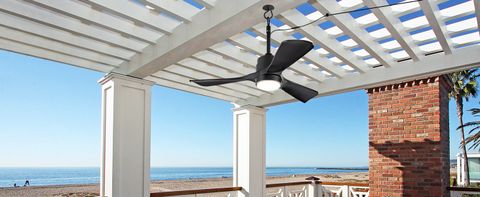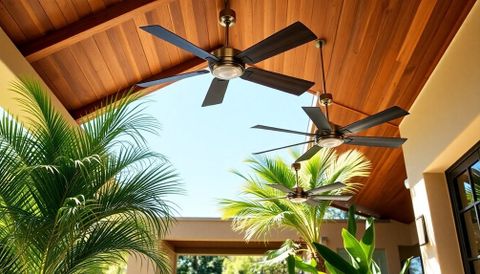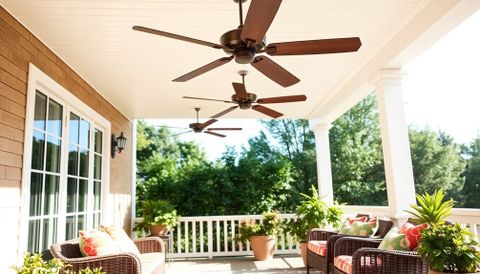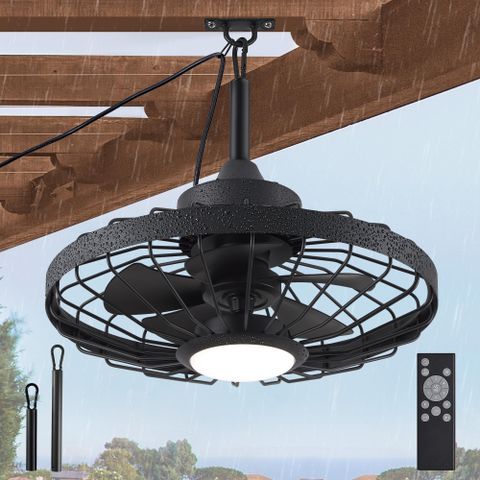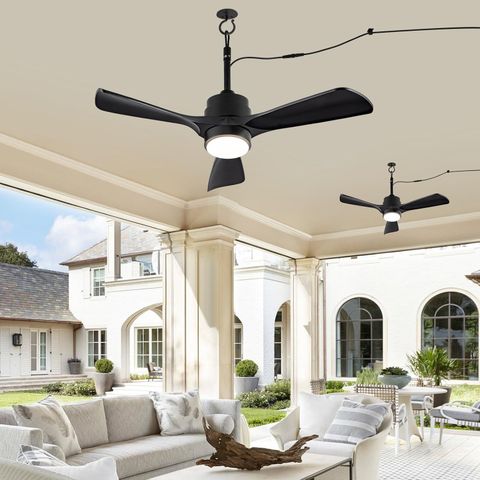Picture this: It’s 95 degrees outside, the sun beats down like a relentless hammer, and you’re stuck inside trying to find relief from the oppressive heat. The solution might be simpler than you think – a well-chosen outdoor ceiling fan. But not just any fan. We’re talking about one specifically designed to handle the brutal conditions of sweltering climates. These aren’t your typical indoor fans. They’re built tough, made to withstand humidity, salt air, and intense UV rays. Let’s explore what makes a great outdoor fan and how to choose the right one for your hot weather needs.
When temperatures soar above 90 degrees and the air feels thick and sticky, having the right outdoor cooling solution becomes more than just a luxury – it’s a necessity. Many people assume that any ceiling fan will do for outdoor spaces, but the truth is that outdoor environments present unique challenges that indoor fans simply cannot handle. The difference between a fan that lasts years and one that fails after a few months often comes down to understanding the specific requirements of outdoor conditions. Whether you’re planning to install a fan in your backyard, patio, or covered porch, choosing the right model means considering factors that go far beyond simple blade size or color preferences. The right outdoor fan can transform a sweltering space into a comfortable retreat, while the wrong choice can leave you frustrated and still sweating.
Understanding Outdoor Fan Requirements
Outdoor ceiling fans face conditions that indoor models never encounter. Humidity levels can be brutal, especially in coastal areas or regions with high moisture content in the air. Salt spray from ocean environments creates corrosion issues that can quickly destroy standard fan components. UV radiation from constant sunlight breaks down materials faster than you’d expect. Wind patterns outdoors are unpredictable and often stronger than indoors. Temperature fluctuations between day and night can cause materials to expand and contract repeatedly. Consider the specific environment where you’ll install your fan. Is it near the beach? In a humid climate? Or does it get direct afternoon sun all day long? These factors determine not just the fan’s performance, but its longevity. A fan designed for mild conditions won’t survive the harsh realities of a Florida summer or a California coastal breeze.
Essential Features to Look For
When shopping for outdoor fans, certain features become non-negotiable. First and foremost is the IP rating – this indicates how well the fan can handle water and dust exposure. Look for ratings of at least IP44 for basic protection, or IP65 for heavy-duty outdoor use. Corrosion-resistant materials are crucial, particularly aluminum or stainless steel construction rather than standard plastic or painted metal. The motor should be specifically rated for outdoor use, often featuring sealed bearings and waterproof windings. Blade materials matter too – some fans use treated wood, others rely on composite materials that resist warping and fading. Check if the fan includes a built-in light fixture or if it’s designed to work with separate lighting. Some models offer remote control capabilities, which can be handy when installing fans in hard-to-reach locations.
Size and Performance Considerations
Size isn’t just about visual impact – it’s about effective airflow. In hot climates, you want fans that move substantial amounts of air efficiently. A 52-inch fan might seem adequate, but in larger outdoor spaces, you may need 56 or even 60 inches to provide proper circulation. Blade pitch angle affects airflow dramatically. Higher pitch angles move more air but require more powerful motors. Think about the space dimensions and ceiling height when determining size. For ceilings higher than 12 feet, look for fans with extended downrods to ensure blades stay within optimal working range. Speed settings are also important – multiple speeds let you adjust airflow based on temperature changes throughout the day. Some fans offer reverse rotation capability, which helps circulate air differently during winter months when needed.
Material Durability and Weather Resistance
The materials used in outdoor fans directly impact their lifespan and performance. Aluminum blades are popular because they resist rust and corrosion better than wood or plastic alternatives. Look for powder-coated finishes that can handle UV exposure without fading. Stainless steel hardware provides strength and prevents rust in salt-prone environments. Some manufacturers use marine-grade materials specifically designed for coastal installations. The motor housing should be made from weatherproof materials that can handle moisture and temperature extremes. Check whether the fan includes a protective cover or housing for the motor unit. Quality manufacturers often provide detailed specifications about material composition and expected performance under various environmental conditions. Don’t skimp on quality materials – a $100 fan that breaks after a season is more expensive than investing in something built to last.
Installation and Mounting Factors
Proper installation makes or breaks an outdoor fan’s success. The mounting surface must be strong enough to support the fan’s weight and movement forces. This is particularly important in areas prone to strong winds or storms. Some fans require special mounting brackets or reinforced ceiling supports. Consider the electrical setup – outdoor installations often need GFCI protection and weatherproof outlets. If you’re installing in a covered area, make sure the mounting location allows for proper clearance around the blades. The ceiling type matters too – drywall, concrete, or metal roofing each present different installation challenges. Professional installation might be worth the investment for complex setups or if you’re unsure about electrical work. Some fans come with detailed installation guides, while others require specialized knowledge. Always follow manufacturer recommendations for mounting specifications and torque requirements.
Maintenance and Longevity Tips
Even the best outdoor fans need care to maintain peak performance. Regular cleaning removes dust and debris that can accumulate on blades and affect airflow. Most outdoor fans benefit from annual maintenance checks, especially before peak summer months. Inspect the mounting hardware periodically for signs of loosening or corrosion. Lubricate moving parts according to manufacturer instructions. Keep an eye on the motor’s operation – unusual noises or vibrations indicate potential problems. Some fans have removable blades for easier cleaning, while others require special tools. Protect fans from extreme weather when possible – using covers during storms or high winds can extend lifespan significantly. Keep spare parts available for common components like bulbs or remote controls. Document installation details and maintenance schedules to track performance over time. Remember that preventive maintenance costs far less than emergency repairs or premature replacement.
Choosing the right outdoor ceiling fan for sweltering climates is more than just picking something that looks good. It’s about understanding the harsh realities of outdoor environments and selecting equipment that can withstand them. From IP ratings to material choices, every decision impacts how long your fan will last and how effectively it will cool your space. The investment you make in quality outdoor fans pays dividends in comfort and savings over time. Don’t let the heat get the best of you – with the right approach and attention to key factors, you can create a refreshing outdoor oasis that works for years to come. Whether you’re upgrading existing space or planning new outdoor areas, taking time to research and select properly suited fans ensures you’ll enjoy reliable cooling when you need it most. The key is matching the fan’s capabilities to your specific outdoor conditions, so you never have to compromise between comfort and durability again.

